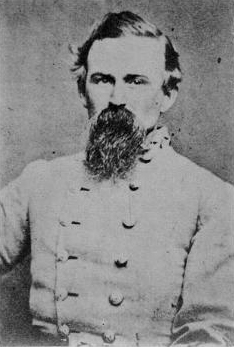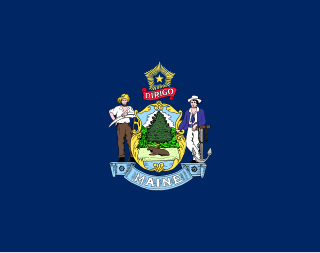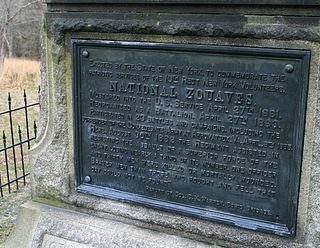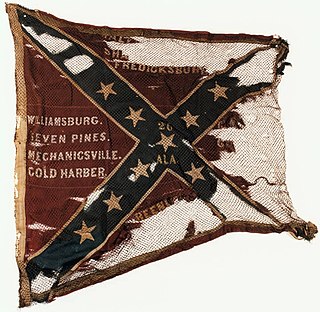John Mercer Brockenbrough was a farmer and a Confederate colonel in the American Civil War.
The 8th Ohio Infantry Regiment was an infantry regiment in the Union Army during the American Civil War. It served in the Eastern Theater in a number of campaigns and battles, but perhaps is most noted for its actions in helping repulse Pickett's Charge during the Battle of Gettysburg.
The 14th Indiana Infantry Regiment, called "The Gallant Fourteenth," was an infantry regiment and part of the Union Army's celebrated "Gibraltar Brigade" during the American Civil War. Mustered on June 7, 1861, it was the state's first regiment organized for three years' service. The 14th Indiana served in many major campaigns and battles mostly in the Eastern Theater. During its three years of service, the regiment had a total of 222 casualties.

George Pierce Doles was an American businessman and Confederate general during the American Civil War. His men played a key role on the first day of the Battle of Gettysburg in driving back the Union XI Corps.

The 16th Maine Infantry Regiment was an infantry regiment that served in the Union Army during the American Civil War. The regiment was one of five raised in answer to the July 2, 1862, call by Lincoln for 300,000 volunteers for three years. The state of Maine's quota was 9,609. It was particularly noted for its service during the 1863 Battle of Gettysburg.

The Third Corps, Army of Northern Virginia was a unit of the Provisional Army of the Confederate States.

The 10th New York Infantry Regiment was an infantry regiment that served in the Union Army during the American Civil War. It was also known as the McChesney Zouaves or National Guard Zouaves.
The 141st Regiment Pennsylvania Volunteer Infantry was a volunteer infantry regiment that fought in the Union Army during the American Civil War. The regiment served in the Army of the Potomac in the Eastern Theater and was heavily engaged in the second day of fighting at the Peach Orchard outside of Gettysburg.
Jesse Milton Williams commanded a Louisiana regiment in the American Civil War. He briefly held brigade command at the Battle of Gettysburg. Prior to the Civil War, Williams attended the University of Alabama and lived in Mansfield, Louisiana.

The 67th New York Infantry Regiment was a regiment of the Union Army, which was raised in the city of Brooklyn in 1861 at the beginning of the American Civil War.

Henry Harrison Walker was a Confederate States Army brigadier general during the American Civil War. He was born in Sussex County, Virginia. He graduated from the United States Military Academy at West Point, New York, in 1853 and served as an officer in the United States Army from 1853 to 1861. Walker was wounded twice during the war and lost his left foot. After the war, he became a stockbroker at Morristown, New Jersey, where he lived until 1912.

The 64th New York Infantry Regiment, the "First Cattaraugus Regiment", was an infantry regiment of the Union Army during the American Civil War.

The 66th New York Infantry Regiment was an infantry regiment in the Union Army during the American Civil War.
The 19th Mississippi Infantry Regiment an infantry formation of the Confederate States Army during the American Civil War. As part of the Army of Northern Virginia, the 19th Regiment fought in numerous battles of the Eastern Theater. It was successively commanded by Colonels Christopher Mott, Lucius Lamar, Nathaniel Harris, Thomas Hardin, and Richard Phipps.

The 26th Alabama Infantry Regiment was an infantry regiment of the Confederate States Army regiment during the American Civil War. The regiment was composed of ten companies that came from various counties across Alabama. It is one of the few regiments that served both in the Army of Northern Virginia and Army of Tennessee.

The 120th New York Infantry Regiment was an infantry regiment in the Union Army during the American Civil War.

The 1st Company Massachusetts Sharpshooters was a sharpshooter unit in the Union Army during the American Civil War.

The 16th Massachusetts was an infantry regiment that served in the Union Army during the American Civil War formed of volunteers from the Commonwealth of Massachusetts.

The 154th New York Infantry Regiment was an infantry regiment in the U.S. Army during the American Civil War.
The 16th Mississippi Infantry Regiment was a unit of the Confederate States Army from southern Mississippi that participated in the Eastern theater of the American Civil War as part of the Army of Northern Virginia. The 16th Regiment fought in numerous battles, taking heavy casualties at Antietam and Spotsylvania Court House before surrendering after Union troops broke through the defenses of Petersburg, Virginia, on April 2, 1865.








